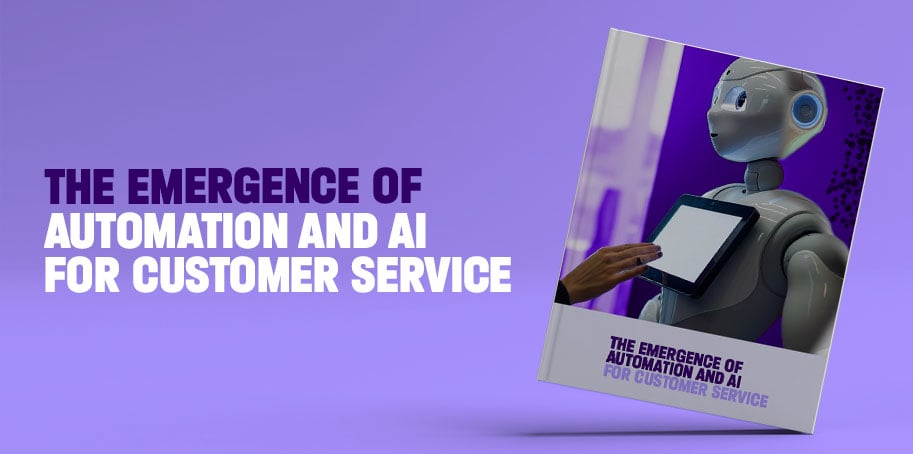4 min read
AI-driven customer service needs quality data
AI is bringing new waves of customer service innovation.
Leading AI customer engagement players power over 95% of their service interactions using AI and digital channels. 🤖
And with great power comes great responsibility, especially regarding the data that fuels AI.
A crucial element determines the success or failure of AI initiatives:
High quality data. After all, it’s the data that makes AI work like magic.

The garbage in, garbage out model
The "garbage in, garbage out" (GIGO) model in AI emphasizes the critical importance of data quality. If you train an AI model on poor-quality data, it will produce inaccurate or unreliable results.
To produce accurate results, AI systems must train on high-quality data that is clean, relevant, and up to date. Poor data quality can lead to incorrect predictions, biased algorithms, and serious operational consequences. Therefore, prioritizing strategies for creating clean training data is crucial for organizations to fully harness the potential of AI.
What are common data quality challenges in customer service?
Poor-quality data can come from various places, both inside and outside your organisation.
Companies have data silos that trap information in one place, resulting in gaps and inconsistencies. Ever dealt with data entry errors or outdated information? These are the hurdles that can trip up your AI, preventing it from delivering its best in customer service.
Let’s look at some common reasons for “garbage” data:
Data Entry Errors: Mistakes in data entry by humans, like typos and wrong information, can cause incorrect data.
Poor Sound Quality: Bad audio affects data quality for accurate transcription and analysis of customer calls.
Siloed Datasets: Data silos can lead to inconsistencies, inaccuracies, and incomplete data sets.
Outdated Data: Data can become obsolete quickly, leading to inaccurate decision-making and personalized marketing efforts.
Data Bias and Inconsistency: Biased and inconsistent data can make AI systems less effective by causing unfair outcomes and inaccurate predictions.
What are some best practices for maintaining data quality in ai-powered customer service?
Best practices for maintaining data quality in AI-powered customer service include:
Implementing Data Governance Policies: To ensure data quality, it is important to establish robust data governance policies. These policies should include standards, processes, and roles. Additionally, fostering a culture that values data quality is crucial. Lastly, aligning data management practices with organizational goals is essential.
Collaborating with Data Providers: We collaborate with data providers to establish strong relationships and ensure their commitment to high-quality data. This helps to minimize the risk of low data quality.
Continuously Monitoring Data Quality Metrics: Regularly measuring and monitoring data quality metrics to identify and address potential issues before they impact AI systems.
How does Enreach ensure high-quality data for AI-powered customer service?
Enreach offers several AI-powered customer service solutions, including chatbots, speech recognition technology, and machine learning capabilities. At Enreach, we’re focusing on two main things to ensure our data is high quality:
Enreach is investing in new technologies and tools to improve data quality. This is important because the better the data, the smarter the decisions made by AI systems.
We’re continuously checking and assessing the quality of our data. This means we are always looking for ways to make the data better and more accurate.
For Enreach's customers, here's why this is good news:
Better Decision Making by AI: With higher quality data, the AI systems can make more accurate and effective decisions. This could mean more personalized service, quicker problem-solving, and generally a better experience for the customer.
Continuous Improvements: Enreach constantly improves its data, so customers can expect ongoing improvements in the services they receive. Over time, this means the customer experience will keep getting better.
Reliability and Trust: Knowing that a company invests in good data practices and emerging technologies can increase customer trust. As a customer, you can feel more confident that you are getting reliable and up-to-date services.
In essence, Enreach's commitment to improving data quality and investing in new technologies means our customers can expect more personalized, efficient, and reliable services.
🏆 Enreach has received the Enabling Technology Leadership Award from Frost & Sullivan for its AI-powered solutions. The award acknowledges Enreach's pioneering role in the integration of artificial intelligence into its solutions, ultimately leading to improved customer outcomes and satisfaction.
What are some examples of how data quality can improve customer experiences?
The quality of your data can make or break your customer's experience. High-quality data allows AI to offer personal, efficient, and spot-on interactions. Maintaining robust data security measures is crucial for AI-driven customer service, ensuring compliance and customer trust.
High-quality data has a direct impact on improving customer experiences in several ways:
Superior Engagement and Personalized Communication: Quality data enables organizations to engage with customers more effectively and deliver personalized communication. By analyzing quality data, organizations can spot trends, predict outcomes, and deliver more effective campaigns, leading to improved customer engagement and satisfaction.
Improved campaigns: Accurate data enables organizations to send the appropriate message to the intended audience by linking customer-specific details. This leads to better customer engagement and a more positive experience.
Consistent and Personalized Experiences: Clean, accurate, and verified customer data enables organizations to provide consistent and personalized experiences across channels. This includes ensuring that customer details are correct, avoiding mis-deliveries, and providing relevant product recommendations.
Improved Customer Loyalty and Advocacy: By leveraging data to improve the customer experience, businesses can increase customer loyalty and advocacy. Personalized experiences at every touchpoint can lead to increased sales and business growth.
Better Understanding of Customer Behavior: Data can provide valuable insights into customer behavior, preferences, and pain points. You can use this information to develop effective customer experience strategies and improve overall customer satisfaction.
Imagine a smart model that knows and predicts what your customers want, making them happier and more loyal. But if your data is off? That's when things can start going downhill for customer trust and satisfaction.
The three pillars of AI in Enreach’s solutions
Enreach’s AI solutions are built on three pillars: advanced analytics, intelligent automation, and seamless integration. These pillars help deliver actionable insights and improve customer interactions. Here are 3 ways Enreach uses AI to enhance customer service.
Supercharge every conversation with AI
Discover Enreach’s AI-driven features, from conversation analytics to intelligent call routing and real-time insights. Explore our AI-powered solutions here.
Use AI-driven customer service to grow your business
Grab your free copy of Enreach's whitepaper "The Emergence of Automation and AI for Customer Service." Industry expert Blair Pleasant offers valuable information about integrating AI tools like chatbots and machine learning into your service plan. Discover real-world success stories, boost customer satisfaction, streamline operations, and cut costs.

Each month, we share articles our team finds worth reading to help you stay informed as Voice AI transforms customer experiences.
